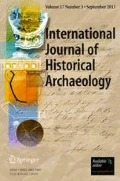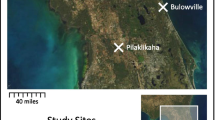Abstract
Scholarship concerning the lives of enslaved African Americans in southern New England has shifted rapidly from outdated models of acculturation to conflict-driven models of domination and resistance. With the assumption of conflict as the outcome of all power relations, both economic production and historical contextuality have been overlooked, with slavery systems in New England simply equated with other regions of the Atlantic world, rather than compared and contrasted. This essay reconsiders contests over power in seventeenth- and eighteenth-century New England. Drawing on the work of Greene (1966), Piersen (1988), and others, I argue that the system of slavery in the region may represent an anomalous case in terms of the means of control or the means of resistance. By examining demographic patterns, economic production, and agricultural landscapes in Rhode Island's East Bay, I argue that there may be more to be learned from William D. Piersen's (1988, p. 143) concept of “resistant accommodation” as a middle ground between the two extremes of the theoretical spectrum. The essay concludes with suggestions for further research on the archaeology of African-American lives in the region.
Similar content being viewed by others
REFERENCES CITED
Adams, W. H., and Boling, S. J. (1989). Status and ceramics for planters and slaves on Three Georgia Coastal Plantations. Historical Archaeology 23(1): 69–96.
Artemel, J. G., Flanagan, E. J., Crowell, E., and Akerson, L. (1984). Providence Cove Lands, Phase III Report, Report prepared by DeLeuw, Cather/Parsons for the Federal Railroad Administration, Washington, DC.
Baldwin, J. (1969). Down at the cross: Letter from a region in my mind. In The Fire Next Time, Dell Books, New York, pp. 23–141.
Baker, V. (1978). Historical Archaeology at Black Lucy's Garden, Andover, Massachusetts, Papers of the Robert S. Peabody Foundation for Archaeology, Vol. 8, Robert S. Peabody Foundation for Archaeology, Andover, MA.
Berlin, I. (1993). Time, space, and the evolution of Afro-American society on British mainland North America. In Morgan, P. D. (ed.), Diversity and Unity in Early North America, Routledge, New York, pp. 113–146. (Originally published in 1980).
Bower, B. A. (1991). Material culture in Boston: the Black experience. In McGuire, R. H., and Paynter, R. (eds.), The Archaeology of Inequality, Blackwell, Oxford, pp. 55–63.
Bridenbaugh, C. (1976). Fat Mutton & Liberty of Conscience, Athenaeum, Hartford. (Originally published in 1974).
Brown, M. R., III (1987). “Among Weighty Friends”: The Archaeology and Social History of the Jacob Mott Family, Portsmouth, Rhode Island, 1640–1800, Unpublished Ph.D. dissertation, Brown University, Providence.
Burnaby, A. (1960). Travels Through the Middle Settlements in North-America in the Years 1759 and 1760, Cornell University Press, Ithaca, NY. (Originally published in 1775).
Candee, R. M. (1989). First-period architecture in Maine and New Hampshire: the evidence of probate inventories. In Benes, P. (ed.), Early American Probate Inventories, Boston University, Boston, pp. 97–120.
Carpenter, E. B. (1924). South County Studies, Merrymount Press, Boston.
Coughtry, J. (1981). The Notorious Triangle, Rhode Island and the African Slave Trade, 1700–1807, Temple University Press, Philadelphia.
Crane, E. F. (1992). A Dependent People: Newport, Rhode Island in the Revolutionary Era, Fordham University Press, New York. (Originally published in 1985).
Cummings, A. L. (1979). The Framed Houses of Massachusetts Bay, 1625–1725, Harvard University Press, Cambridge, MA.
Deetz, J. (1977). In Small Things Forgotten: The Archaeology of Early American Life, Doubleday Books, New York.
Dexter, F. B. (ed.) (1901). The Literary Journal of Ezra Stiles, Vol. 1. Charles Scribner's Sons, New York.
Epperson, T. W. (1990). Race and the disciplines of the plantation. Historical Archaeology 24(4): 29–36.
Fitts, R. K. (1995). Inventing New England's Slave Paradise: Master/Slave Relations in Eighteenth-Century Narragansett, Rhode Island, Unpublished Ph.D. dissertation, Department of Anthropology, Brown University, Providence.
Fitts, R. K. (1996). The landscapes of northern bondage. Historical Archaeology 30(2): 54–73.
Garman, J. C. (1994). Viewing the color line through the material culture of death. Historical Archaeology 28(3): 74–93.
Garman, J. C., and Sterne, E. S. (1993). The Cultural Landscapes of African-American Slavery in Rhode Island's East Bay: A Preliminary Assessment, Report on file at the Rhode Island Historical Preservation and Heritage Commission, Providence, RI.
Genovese, E. D. (1976). Roll, Jordan, Roll: The World the Slaves Made, Vintage Books, New York. (Originally published in 1972).
Greene, L. J. (1966). The Negro in Colonial New England, Kennikat Press, Port Washington, NY. (Originally published in 1942).
Hauteniemi, S. (1992). The W. E. B. Du Bois site: Material culture and the creation of race and gender. Paper presented at the 25th annual Conference on Historic and Underwater Archaeology, Kingston, Jamaica.
Howson, J. E. (1990). Social relations and material culture: A critique of the archaeology of plantation slavery. Historical Archaeology 24(4): 78–91.
Johnston, W. D. (1894). Slavery in Rhode Island, 1755–1776, Printed for the Rhode Island Historical Society in Providence.
Levesque, G. (1994). Black Boston: African-American Life and Culture in Urban America, 1750–1860, Garland, New York.
Mason, G. C. (1884). Reminiscences of Newport, Charles E. Hammett, Jr., Newport, RI.
McLoughlin, W. G. (1986). Rhode Island: A History, W. W. Norton, New York. (Originally published in 1978).
Merchant, C. (1989). Ecological Revolutions. Nature, Gender, and Science in New England, University of North Carolina Press, Chapel Hill.
Muller, N. L. (1992). “The house of the Black Burghardts”: An investigation of race, gender, and class at the W. E. B. Du Bois Boyhood Homesite, Ph.D. prospectus on file at the Department of Anthropology, University of Massachusetts, Amherst.
Mullins, P. R. (1996). The Contradictions of Consumption: An Archaeology of African America and Consumer Culture, 1850–1930, Unpublished Ph.D. dissertation, University of Massachusetts, Amherst.
Munro, W. H. (1880). The History of Bristol, R.I.: The Story of the Mount Hope Lands, from the Visit of the Northmen to the Present Time, J. A. and R. A. Reid, Providence, RI.
Paynter, R. (1990). Afro-Americans in the Massachusetts historical landscape. In Gathercole, P., and Lowenthal, D. (eds.), The Politics of the Past, Unwin Hyman, London, pp. 49–62.
Paynter, R., and McGuire, R. H. (1991). The archaeology of inequality: material culture, domination, and resistance. In McGuire, R. H., and Paynter, R. (eds.), The Archaeology of Inequality, Blackwell, Oxford, pp. 1–27.
Piersen, W. D. (1988). Black Yankees: The Development of an Afro-American Subculture in Eighteenth-Century New England, University of Massachusetts Press, Amherst.
Piersen, W. D. (1993). Black Legacy: America's Hidden Heritage, University of Massachusetts Press, Amherst.
Portsmouth Land Evidence (PLE) (nd). Land evidence volumes on file at the Portsmouth Town Hall, Portsmouth, RI.
Potter, P. B., Jr. (1991). What is the use of plantation archaeology? Historical Archaeology 25(3): 94–107.
Quarles, B. (1988). The Revolutionary War as a Black Declaration of Independence. In Black Mosaic: Essays in Afro-American History and Historiography, pp. 48–64. University of Massachusetts Press, Amherst. (Originally published in 1983).
Scott, J. C. (1985). Weapons of the Weak: Everyday Forms of Peasant Resistance, Yale University Press, New Haven, CT.
Scott, J. C. (1990). Domination and the Arts of Resistance: Hidden Transcripts, Yale University Press, New Haven, CT.
Snow, E. (1877). Report on the Census of Rhode Island, 1875, Providence Press State Printers, Providence, RI.
Stupp, C. B. (1993). African Americans in Antebellum Boston: An Analysis of Probate Records, Garland, New York.
Sweet, J. W. (1995). Bodies Politic: Colonialism, Race, and the Emergence of the American North, Unpublished Ph.D. dissertation, Princeton University, Princeton, NJ.
Sweet, J. W. (1997). Strange Christians: The paradox of colonial conversions in 18th-century New England. Paper presented at the Annual Meeting of the Organization of American Historians, San Francisco, CA.
Whitten, N. E., Jr., and Szwed, J. F. (1970). Afro-American Anthropology: Contemporary Perspectives, Free Press, New York.
Worral, A. (1980). Quakers in the Colonial Northeast, University Press of New England, Hanover, NH.
Youngken, R. C. (1995). African Americans in Newport: An Introduction to the Heritage of African Americans in Newport, Rhode Island, 1700–1945, Rhode Island Historical Preservation & Heritage Commission and Rhode Island Black Heritage Society, Providence.
Author information
Authors and Affiliations
Rights and permissions
About this article
Cite this article
Garman, J.C. Rethinking “Resistant Accommodation”: Toward an Archaeology of African-American Lives in Southern New England, 1638–1800. International Journal of Historical Archaeology 2, 133–160 (1998). https://doi.org/10.1023/A:1022618431591
Issue Date:
DOI: https://doi.org/10.1023/A:1022618431591




